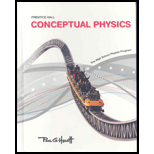
Concept explainers
Lunar eclipses are always eclipses of a full moon. That is, the moon is always seen full just before and after Earth’s shadow passes over it. Why can we never have a lunar eclipse when the moon is in its crescent or half-moon phase?
The reason why can we never have a lunar eclipse when the moon is in its crescent or half-moon eclipse is to be explained.
Explanation of Solution
Introduction:
When the moon is full then the lunar eclipse is caused. There is a small difference between the lunar eclipse and crescent or half moon eclipse is that the blacked-out part of the moon is not shaded by the earth in the case of the crescent.
When the earth comes between the sun and the moon, and then a lunar eclipse is caused. Because of this position the ray’s effect which is coming from the sun and reflects on the moon is greater as compared to other positions. The half part of the moon is lighted by the sun while the other half shaded from the sun’s light. Generally, the full moon lies below or above the imaginary line and this line passing through the earth and the sun. So, it does not face the earth’s shadow. Sometimes, the earth, the sun and the moon come in a single line so well that the moon does cross our shadow and caused a lunar eclipse.
Conclusion:
When moon orbit is inclined to the earth orbit by about five degrees, no eclipse is formed at each full moon or new moon.
Chapter 27 Solutions
Conceptual Physics: The High School Physics Program
Additional Science Textbook Solutions
Applied Physics (11th Edition)
Introduction to Electrodynamics
University Physics Volume 1
Conceptual Integrated Science
Tutorials in Introductory Physics
 College PhysicsPhysicsISBN:9781305952300Author:Raymond A. Serway, Chris VuillePublisher:Cengage Learning
College PhysicsPhysicsISBN:9781305952300Author:Raymond A. Serway, Chris VuillePublisher:Cengage Learning University Physics (14th Edition)PhysicsISBN:9780133969290Author:Hugh D. Young, Roger A. FreedmanPublisher:PEARSON
University Physics (14th Edition)PhysicsISBN:9780133969290Author:Hugh D. Young, Roger A. FreedmanPublisher:PEARSON Introduction To Quantum MechanicsPhysicsISBN:9781107189638Author:Griffiths, David J., Schroeter, Darrell F.Publisher:Cambridge University Press
Introduction To Quantum MechanicsPhysicsISBN:9781107189638Author:Griffiths, David J., Schroeter, Darrell F.Publisher:Cambridge University Press Physics for Scientists and EngineersPhysicsISBN:9781337553278Author:Raymond A. Serway, John W. JewettPublisher:Cengage Learning
Physics for Scientists and EngineersPhysicsISBN:9781337553278Author:Raymond A. Serway, John W. JewettPublisher:Cengage Learning Lecture- Tutorials for Introductory AstronomyPhysicsISBN:9780321820464Author:Edward E. Prather, Tim P. Slater, Jeff P. Adams, Gina BrissendenPublisher:Addison-Wesley
Lecture- Tutorials for Introductory AstronomyPhysicsISBN:9780321820464Author:Edward E. Prather, Tim P. Slater, Jeff P. Adams, Gina BrissendenPublisher:Addison-Wesley College Physics: A Strategic Approach (4th Editio...PhysicsISBN:9780134609034Author:Randall D. Knight (Professor Emeritus), Brian Jones, Stuart FieldPublisher:PEARSON
College Physics: A Strategic Approach (4th Editio...PhysicsISBN:9780134609034Author:Randall D. Knight (Professor Emeritus), Brian Jones, Stuart FieldPublisher:PEARSON





